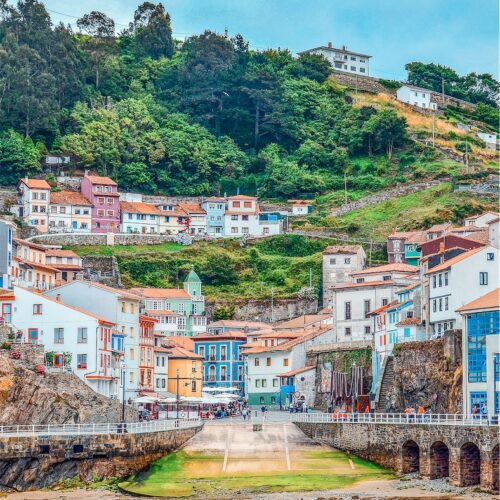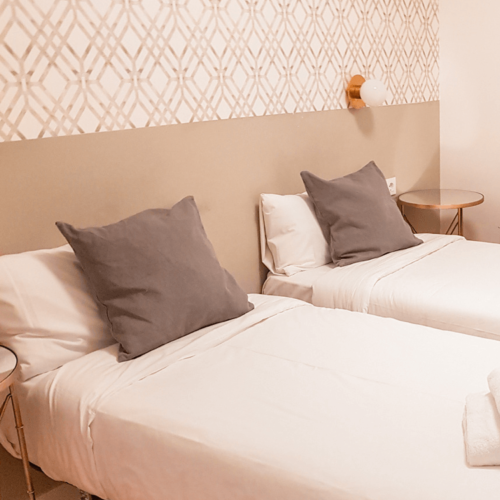Last updated on at 07:50 am
Ávila is one of the most stunning, authentic fortified medieval cities I’ve ever seen in my travels. Its old town is a place where time seemed to have stood still—truly breathtaking!

This post may contain affiliate links that may earn me a commission, at no additional cost to you, if you buy via them. As an Amazon Associate, I earn from qualifying purchases. Please see our Disclosure for more info.
Let’s take a quick look at this UNESCO World Heritage Site that’s such an excellent example of a fortified city from the Middle Ages. We’ll also be sharing tips on visiting like how to get there and things to do and more while there.
About Ávila
Ávila also called “the finest medieval remnant in Spain”, is a city in the Autonomous Community of Castile and León. It is 111 kilometers northwest of Madrid and has the highest altitude in Spain.
It was established in the 11th century to protect the Spanish territories from the invading Moors after it was reclaimed from the latter invaders. This need to protect is something much apparent from its exquisitely larger-than-life ancient town walls that wrap around the city.
From that time on, Ávila prospered for several years, with its heyday being during the 16th century’s Golden Age.
Apart from being called “The Walled City of Spain”, Ávila is also known as the “City of Saints and Stones”, most likely because it is the birthplace of St. Teresa of Ávila and is said to have the highest number of Gothic and Romanesque churches in Spain. In addition to that, it is where the Grand Inquisitor Tómas de Torquemada of the Spanish Inquisition was buried.
Related Reading: The Cheapest Places to Travel in Europe
What is Ávila, Spain known for?
Ávila, Spain is known for its medieval city walls, the birthplace and sites related to Saint Teresa of Ávila. Its Romanesque and Gothic architecture, including the cathedral and basilica, adds to its cultural richness. The city hosts events like the Medieval Market and offers delicious local cuisine.
How to Get to Ávila
You can visit Ávila from Madrid by car, train or bus.
If going by car, Ávila is 120 kilometers from Madrid so it takes a little over an hour to reach. It’s an hour and a half by train or bus.
If going by train, you can start your journey at Madrid’s Chamartin train station or Príncipe Pío.
Visiting Ávila
You can visit Ávila for a day as a day trip destination from Madrid. Just make sure to prioritize the more important sights to get a satisfying experience since you wouldn’t be able to cover everything if only visiting for a day.
Or you can stay for a few days if you want to see everything and experience this World Heritage City fully.

Getting Around Ávila
There are tourist buses that go around Ávila that help you get around for only a small fee. There are none within Ávila’s walls, however. Besides, the latter part is best explored on foot since the streets are narrow and some areas are small. Also, going on foot is the most effective way of learning much about a new place, Ávila more so.
Ávila, Spain Attractions
1. Ávila City Walls
Ávila’s walls, first of all, because they are truly amazing. They’re these massive, strong fortifications that are so formidable they’d take your breath away. They are actually among the best-preserved and most complete medieval walls in Europe.

The whole thing stands at an average height of 12 meters, is composed of 88 near-circular towers, has round turrets, and has 9 gates. It is said to be the most complete in Spain too. Some parts date back to 1090, while others were rebuilt in the 12th century. These walls have been declared a Spanish National Monument.
You can go on top of the walls and walk along its length. To start your self-guided walking tour, go to the Puerta del Carmen gate.
2. Convento de Santa Teresa (Ávila, Spain St. Teresa)
This convent of Carmelite nuns stands on the birthplace of Saint Teresa of Ávila, perhaps the city’s most famous resident. Built in the 17th century, it contains a church with beautiful stained glass windows dedicated to her, a lovely chapel in Baroque style with a recreated room where Saint Teresa was born, and a museum with a gift shop where you can see some of her belongings and relics, including a bone of her ring finger.
3. Catedral de San Salvador – Cathedral in Ávila, Spain
Catedral de San Salvador is Spain’s oldest Gothic cathedral and was built into Ávila’s walls. Started in 1095 and completed somewhere around the 13th-15th century, it also has some Romanesque portions in it.
This cathedral is unique in the sense that it’s not your ordinary cathedral. With battlements and sentry walks included in the architecture, it was a large part of Ávila’s defense from invaders in the Middle Ages.
One of the highlights inside is the extraordinary altarpiece in the main chapel. There is also a small but substantial museum inside. You pay a fee to enter, with an audio guide included. An additional fee is charged if you want to climb the tower.

4. Museo de Ávila
Museo de Ávila is the place to go when you want a comprehensive look into the city’s history. This museum holds records of Ávila’s beginnings from as early as the prehistoric Paleolithic to its rise in the Golden Age, and thereafter.
Inside you’ll find archaeological pieces, Roman sculptures and artifacts, works of art, ethnography, and more.
There are many other museums in the area worth visiting as well. You can find information about them at the Tourist Information Office.
5. Barrio Judio
Barrio Judio or the Jewish Quarter is where you can find interesting traces of the Jewish communities that settled in Ávila in the past.

6. Real Monasterio de Santo Tomás
Real Monasterio de Santo Tomás is a Gothic Dominican monastery from the 15th century. Named as a tribute to Saint Tomas Aquinas, it was commissioned by the Catholic monarchs King Ferdinand II of Aragon and Queen Isabella I of Castile, with some funding support from the first Grand Inquisitor Tómas de Torquemada.
It is a Spanish National Monument, one of the important monuments of Ávila, and the summer residence of the Catholic monarchs. Located outside the walls, it is also the burial site of Don Juan, the only son of Ferdinand II and Isabella I, as well as that of Tómas de Torquemada.
There are two museums inside, one for natural history and the other for oriental art. Apart from the historical information and the value it provides, it is also a charming place that makes a perfect oasis for quiet reflection and meditation because of its peaceful ambiance.
7. Mirador de los Cuatro Postes
Mirador de los Cuatro Postes, which lies at a short distance from the walls of Ávila, is a structure of four tall columns surrounding a huge cross that is a stopping point when doing a pilgrimage to the cloister of San Leonardo.
Many say that it was erected as a tribute to the city having survived a legendary plague in the 12th century and as a way to remember that. No one knows for sure, however.
Some also claim it was where Saint Teresa was found by her uncle after she ran away when she was a child.
From this vantage point, you can see the totality of the walls as well as some parts of Ávila. It is a good place to get some wonderful views, especially at night when the walls of Ávila are illuminated. Or maybe take a rest and get some pictures taken. One thing is for sure, it’s well worth the visit.
8. Basílica de San Vicente
Basílica de San Vicente is a beautiful Romanesque (mostly) church just outside the walls of Ávila.

It dates back to the 12th century and is said to be located in the very place where St. Vincent of Ávila was said to have been executed by the Romans, along with his sisters and fellow martyrs, Cristeta and Sabina.
While the outside is beautiful in its simplicity (stunning lines and elegant curves, all of which I absolutely loved), the inside is quite breathtaking as well with its amazing artwork. For a minimal entrance fee, you get to view inside the tomb of San Vicente with engravings of his torture and execution, the magnificently elaborate main altar, the fantastic vaulted ceiling, and more. We suggest you avail of the audio tour for a much better experience.
Things to Do in Ávila, Spain
9. Plaza Mayor
Plaza Mayor is the place to go when you want to take a respite from all that fabulous sightseeing around Ávila and just soak in the grand atmosphere of this Spanish gem. It’s just like any other plaza in Spain, though not as large as the others, but the marvelous architecture lining its confines is impressive and lovely to behold.
The bars, cafés, and abundant tapas make this place a perfect stop too for drinks and food, while the many people who frequent the area are fantastic candidates for socializing.
Other Activities
For the best Ávila experience, check out these guided tours that come with expert guides with more information about the sights.
What to Eat
- Chuletón de Ávila, which is T-bone steak from black cows raised in the area and cooked grilled. You can try them at most restaurants and hotels in town.
- Yemas de Santa Teresa are local delicacies of sweet pastries made from egg yolk—delicious and decadent! They make great gifts too. You can get them at the shop called La Flor de Castilla located within the walls.


Where to Stay in Ávila
Or use this search box to look for the best deals on accommodations:
Booking.comIs it worth visiting Ávila, Spain?
Yes, Ávila is worth visiting for its well-preserved medieval walls, religious heritage linked to Saint Teresa of Ávila, stunning Romanesque and Gothic architecture, vibrant cultural events like the Medieval Market, and delicious local cuisine. It offers a captivating blend of history, spirituality, and culinary delights for visitors.
Final Thoughts
Ávila is one classically beautiful Spanish City that has retained its authentic medieval look and vibe. It is a must-see for that alone.
If you’ve visited, let us know how you find it.
If you like this post, don’t forget to Pin it to share with others or to save for later re-reading.
Follow me on:




Avila looks beautiful, I can really see myself wandering those streets and then stopping off for a glass of wine and watching the world go by. It’s so interesting to learn about destinations in Spain that are a little under the radar- great post!
It is. And the picture you paint is wonderful that it makes me want to visit it again 🙂 Thank you!
OOO thank you tor these recommendations! I would love to visit here some day!
You’re welcome! Hope you’ll love it, too!